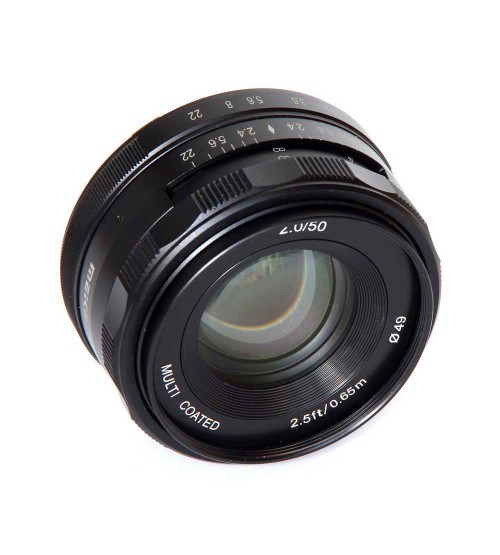Meike for Fujifilm 50mm f/2.0 APS-C
New lens from
Hong Kong Meike Digital Technology. Meike means “beauty” (Mei) and “technology”
(Ke) and immediately the lenses remind us of how small and light manual focus
optics used to be. Do beauty and technology meet to make something special?
Let's find out.
MEIKE 50mm f/2.0 Handling and
Features
The focusing initially showed a slight roughness at some points, but soon
became much smoother with use. Not the same silky smoothness as those classic
lenses, but nonetheless not at all bad. The overall finish of the lens is of a
good standard.
The six element in five groups optics are multi-coated, closest focus is
2.5 feet (0.65m) and the lens takes inexpensive 49mm thread filters. Maximum
magnification is 0.08x. The diaphragm has eight blades. Finally, the lens
weighs just 185g.
The aperture ring is unusual. It has no click stops and remains closed to
whatever value is set. This will be useful for video shooters but less so for
those shooting stills. The progression of apertures marked is f/2, f/2.8,
f/3.5, f/5.6, f/8 and f/22. There is no obvious advantage to this departure
from the normal markings.
Although supplied for review in Micro 4/3 mount, the lens is marked as
suitable for APS-C format. Accordingly, it is also available for other CSCs
including Sony E, Canon M, Nikon 1, and Fujifilm X series. The 35mm-format
equivalent will be 100mm on Micro 4/3 cameras and around 75mm on APS-C. This is
a useful short telephoto length.
There is a highly polished metal mount, smooth and positive and matching
the Panasonic Lumix G6 used for this review
perfectly. There are no electronic contacts, so the camera does not know the
aperture set. The Lumix G6 works fine in manual and aperture priority modes and
meters correctly when the lens is stopped down.
In use, the lens is easy to focus, provided this is done at full aperture.
There being no auto stop-down it is then necessary to turn the aperture ring to
the desired setting. Unfortunately, the absence of click stops means that this
is done by guess unless the camera is taken from the eye to look at the
settings. With practice, this guess can be honed and could become quite
accurate, but the precise value set will not be known unless constantly checked
and noted. Otherwise, it could not be simpler in use.
The expectation for this lens inevitably will be set against its modest £65
price tag, although there are no electronic or mechanical complications in it
so there are many areas where costs of production can be lower without
necessarily sacrificing performance.
Sharpness is very good centrally at f/2 and peaks at excellent levels at
f/3.5, thereafter remaining very good to f/8. It dips to only fair at f/22.
The edges are very soft, with poor sharpness at all apertures, but
improving to a fair standard at f/8, and this will be even more noticeable on
APS-C cameras.
The overall look of the images is very good, with nice colour, lovely bokeh
and very well controlled CA (Chromatic Aberration). Distortion measures at
+1.51% pincushion. CA and distortion can, in any event, be corrected in
software.
Flare is also well controlled, although there is a significant loss of
contrast when shooting with the sun just out of frame. There are no obvious
internal reflections or image artefacts. There is no lens hood supplied, but
use of one is to be recommended. They are readily available.
From a purist point of view, the Meike 50mm f/2 gives total freedom from
automation. This may well appeal to some photographers who will enjoy the
process of using it and live with the soft edges, even using its shortcomings
to create distinctive images.
| Technical | |
| Warranty | 1 Year Service & Spareparts |






